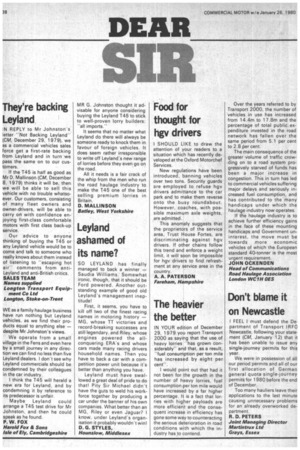The heavier the better
Page 40

If you've noticed an error in this article please click here to report it so we can fix it.
IN YOUR edition of December 29, 1979 you report Transport 2000 as saying that the use of heavy lorries -has grown considerably" and that, as a result, "fuel consumption per ton mile has increased by eight per cent".
I would point out that had it not been for the growth in the number of heavy lorries, fuel consumption per ton mile would have increased by a far higher percentage. It is a fact that lorries with higher payloads are more efficient and the consequent increase in efficiency has gone some way to counteracting the serious deterioration in road conditions with which the industry has to contend. Over the years referred to by Transport 2000, the number of vehicles in use has increased from 14.4m to 17.8m and the percentage of total public. expenditure invested in the road network has fallen over the same period from 5.1 per cent to 2.8 per cent.
The main consequence of the greater volume of traffic crow ding on to a road system pro gressively starved of funds has been a major increase in congestion. This in turn has led to commercial vehicles suffering major delays and seriously in creased fuel consumption, and has contributed to the many handicaps under which the haulage industry now operates.
If the haulage industry is to achieve further efficiency gains in the face of these mounting handicaps and Government uninterest, the move must be towards more economic vehicles of which the European standard 40-tonner is the most urgent requirement.
JOHN OCKENDEN Head of Communications Road Haulage Association London WC1H OES












































































































































